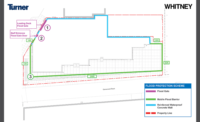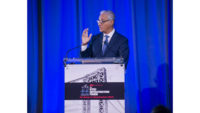Education
Schooling Student Engineers in Safety Science at the New Jersey Institute of Technology

Students explain how smart helmets work in their construction safety class at the New Jersey Institute of Technology, where a minor course of study in safety engineering was recently launched.
Photo: courtesy of NJIT
As students register for spring classes this month at the New Jersey Institute of Technology’s School of Applied Engineering, they will find a new course in the online catalogue that some believe is a key to the future of jobsite safety.
For the first time, NJIT students will be able to study the techniques of creating safer-to-build structures in addition to other safety coursework.
The class is part of a widening recognition that more closely aligning design engineering with construction jobsite safety is a key to preventing injuries by eliminating potential hazards during design.
Samuel C. Lieber, associate professor and acting chair of the Newark, N.J.-based school, says he was inspired to do more to embed safety culture in engineering programs after attending one of a series of safety symposia sponsored by the National Academy of Construction in 2022-23. “We pulled together a group of educators who had attended the symposium and met with the Health and Safety Working Group of the Associated Construction Contractors of New Jersey to get practical input,” Lieber says.
One result is the new course, Engineering for Quality and Safety, that explores “how you design a structure so that you mitigate the risk” for the contractors and craftworkers building it. In the course, students learn to take the inputs of hazard analysis plus safety requirements and “do iterative design and engineering work” to develop a safer-to-build solution.
The tie to industry also prompted the launch this year of a minor in safety engineering, which teaches students the skills needed for a career path as a construction safety inspector, adds John Wiggins, program coordinator for Construction Engineering Technology. Meeting guest speakers and construction site tours opens doors for students to co-op programs and internships, he adds.
Spreading the Word
Other courses like the new one at NJIT exist, but they are not widespread, says John Gambatese, professor of civil and construction engineering at Oregon State University.
As editor of the NAC symposia proceedings and teacher of a similar topic at Oregon State, Gambatese knows the educational issues well. He says the series—held at the University of Kansas, Worcester Polytechnic Institute, NJIT, University of Texas at Austin/Texas A&M, and University of Colorado at Boulder—was intended to embed safety culture concepts in undergraduate engineering education.
That achieved spreading the word to 45 universities and 94 construction industry companies, who attended one or more of the events, he says.
NAC is now expanding the series, planning five more symposia in 2025, says Anthony F. Leketa, the 2024-25 chair of the NAC Safety Committee and a retired Parsons Corp. executive. The programs will take place at four universities—the University of Southern California, Oregon State, North Carolina State and Purdue. Significantly, Leketa says, the kickoff program on Feb. 27 in Washington, D.C., will be hosted at the National Academies of Sciences, Engineering and Medicine headquarters.
The series will be sponsored by the Federal Facilities Council—a cooperative association of federal agencies dedicated to sharing best practices—along with the Board on Infrastructure and the Constructed Environment. Leketa says the interest from these organizations underscores the value of the “safety culture concept” and how it “applies to everything.”




